It’s quite an insult to call someone a dumbbell. It implies that you’re about as intelligent as a lump of metal. However, dumbbells are anything but dumb and are actually one of the most versatile training tools around.
Training with dumbbells means you can work one side of your body at a time, which is helpful for identifying and fixing left-to-right strength imbalances. Also, a lot of dumbbell exercises involve a larger range of motion compared to the same exercise done with a barbell. This increases joint mobility and may improve muscle activation.
Using dumbbells instead of a singular barbell means you’ve got two weights to control, which is good for improving coordination. Additionally, a lot of exercisers find that training with dumbbells is more joint-friendly. For example, if barbell bench presses cause shoulder pain, you may find some relief if you switch to dumbbells.
Dumbbells can also be safer to use than barbells. This is especially true for pressing exercises. A failed bench press rep can cause serious injury if the bar comes crashing down on your neck or chest. However, with dumbbells, you can just drop the weights out and down to the floor. This means dumbbells are ideal for solo trainers.
A lot of home and garage trainers prefer dumbbells over barbells because they take up less space during use and for storage. Combined with an adjustable bench, dumbbells allow you to train every muscle in your body.
Level Up Your Fitness: Join our 💪 strong community in Fitness Volt Newsletter. Get daily inspiration, expert-backed workouts, nutrition tips, the latest in strength sports, and the support you need to reach your goals. Subscribe for free!
On the downside, hoisting heavy dumbbells up and into position for exercises like bench presses and overhead presses can be tricky. But, with a bit of practice, this inconvenience is easy enough to overcome.
This 5-day workout program uses nothing but dumbbells, so it’s ideal for anyone limited to training with dumbbells.
5-Day Dumbbell Workout Split – Overview
There are lots of ways to do a five-day split, and most involve training 1-2 muscle groups per workout. It’s also usual to train each muscle group once per week. That’s okay for some lifters, but many people do better when they train each major muscle group twice per week.
This five-day dumbbell workout split combines an upper/lower body split with a push-pull-legs split to ensure that you hit each muscle twice per seven days to optimize muscle growth and make your workouts more varied.
This is your plan for the next few weeks:
| Mon | Tue | Wed | Thu | Fri | Sat | Sun |
| Upper body | Lower body | Rest | Push | Pull | Legs & Abs | Rest |
While we’ve prescribed sets and reps for this workout, you should adjust them to meet your training goals. Because of the law of specificity, your body adapts to the type of training you do. If you want to get stronger, you need to lift heavy weights. In contrast, for endurance, light weights and high reps are best.
Use the following guidelines to adapt the workouts to your needs:
| Training Goal | Endurance | Hypertrophy | Strength/Power |
| Intensity | Low | Moderate | High |
| Load | <67% of 1RM | 67-85% of 1RM | >85% of 1RM |
| 1RM = 1-repetition maximum and is the maximum amount of weight that can be lifted once but not twice | |||
| Repetitions per set | 13-20 | 6-12 | 1-5 |
| Recovery between sets | 30-60 seconds | 1-2 minutes | 3-5 minutes+ |
Finally, remember to warm up before each and every workout. Start with 5-10 minutes of easy cardio to raise your core temperature and get your blood pumping. Prepare your muscles and joints by doing a few dynamic stretches and joint mobility exercises. Finish your warm-up with a couple of sets of the main exercises in your workout.
Workout 1 – Upper body
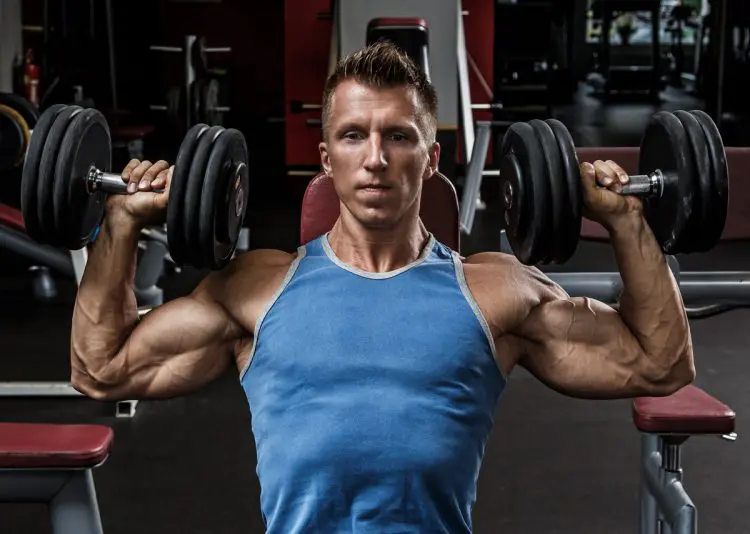
Your first workout trains all the muscles in your upper body. It’s a simple workout, but it’ll be very effective if you push yourself and take each set close to failure. It involves an equal amount of pushing and pulling to ensure all upper body muscles are trained equally.
| Exercise | Sets | Reps | Recovery | |
| 1 | Dumbbell bench press | 4 | 6-12 | 60-90 seconds |
| 2 | Single-arm bent-over row | 4 | 6-12 per arm | 60-90 seconds |
| 3 | Seated dumbbell shoulder press | 4 | 6-12 | 60-90 seconds |
| 4 | Dumbbell Pendlay row | 4 | 6-12 | 60-90 seconds |
| 5 | Decline dumbbell skull crusher | 3 | 6-12 | 60-90 seconds |
| 6 | Dumbbell biceps curl | 3 | 6-12 | 60-90 seconds |
Exercise descriptions
Get the most from the exercises in your workout by doing them correctly. As well as making your training more productive, it will also lower your risk of injury.
1. Dumbbell bench press
The dumbbell bench press is a superior chest exercise. It allows for a greater range of motion than the barbell version, and the dumbbells follow an arc which means they may increase inner chest mass.
Controlling two weights instead of one also improves overall pec activation. Don’t feel put out because you can’t do barbell bench presses; using dumbbells may be better!
Learn how to do dumbbell bench presses here.
2. Single-arm bent-over row
This unilateral lat exercise will develop back thickness. Because you’ve got one arm free, you can support your upper body and take pressure off your lower back.
This can be very welcome if you are one of many adults that suffer from lower back pain.
Read all about this awesome exercise here.
3. Seated dumbbell shoulder press
Shoulder exercises don’t come much better than basic seated overhead dumbbell presses. This classic move works all three deltoid heads with an emphasis on the front and sides. It’s also a good triceps exercise.
Check out this guide to learn how to do seated dumbbell overhead presses.
4. Dumbbell Pendlay row
Pendlay rows are named after weightlifting and powerlifting coach Glen Pendlay. Also known as dead-stop rows, this exercise is usually done with a barbell but can also be done using dumbbells.
The dead stop between reps eliminates momentum and provides your lower back and grip with a short but welcome rest. This is a good exercise if you want to train with heavy weights.
Learn how to do dumbbell Pendlay rows here.
5. Decline dumbbell skull crusher
Skull crushers are so-called because if you do them wrong, you could inadvertently hit yourself in the head! Needless to say, this is NOT recommended.
Using dumbbells makes this exercise considerably safer, and doing them while declined increases activation of the long head of your triceps. This is an excellent arm-builder.
Check out our guide to decline dumbbell skull crushers.
6. Dumbbell biceps curl
Dumbbell biceps curls involve two biceps functions – elbow flexion and forearm supination. This means they’re especially good for building bigger, more muscular biceps and provide your forearms with a good workout too. Do them seated or standing as preferred.
Read all about dumbbell biceps curls here.
Workout 2 – Lower body
You can’t build a strong, muscular, functional body without training your legs. The good news is you can train your lower body using nothing but dumbbells.
| Exercise | Sets | Reps | Recovery | |
| 1 | Cyclist goblet squat | 4 | 6-12 | 60-90 seconds |
| 2 | Dumbbell Romanian deadlift | 4 | 6-12 | 60-90 seconds |
| 3 | Split squat | 4 | 6-12 per leg | 60-90 seconds |
| 4 | Dumbbell leg extension | 4 | 6-12 | 60-90 seconds |
| 5 | Single-leg standing calf raise | 4 | 6-12 per leg | 60-90 seconds |
Exercise descriptions
Leg exercises often involve your lower back, which means it’s essential you do them correctly. Take care not to round your lower back during this workout, as doing so puts tremendous pressure on the ligaments and intervertebral discs of your lumbar spine.
1. Cyclist goblet squat
With no barbell or leg press machine to use, you probably won’t be able to train your legs with heavy weights. Don’t worry; you can still build a lower body to be proud of with exercises like cyclist goblet squats.
How to do it:
- Place a weight plate on the floor and stand on it so that your heels are elevated. Hold a dumbbell vertically in front of your chest, with your palms turned upward.
- Bend your legs and squat down as deeply as you can without rounding your lower back.
- Without bouncing, stand up but stop a few inches short of full lockout to keep your muscles under tension.
- Without pausing, squat back down and repeat.
2. Dumbbell Romanian deadlift
Romanian deadlifts are another one of those exercises that are usually done using a barbell. However, it works just as well with dumbbells and is actually more lower back-friendly when done this way. Romanian deadlifts work your entire posterior chain.
How to do it:
- Stand with your feet hip-width apart, knees slightly bent, and a dumbbell in each hand, held in front of your thighs.
- Push your hips back and hinge forward without rounding your lower back. Lower the weights down your legs to just below knee height.
- Push your hips forward and stand up, but do not lean back as doing so puts too much stress on your lumbar spine.
3. Split squat
Split squats are a type of stationary lunge. With less movement and balance to worry about, you are free to focus on working your quads, hamstrings, and glutes. Split squats are good for improving hip mobility too.
Learn how to do split squats in our in-depth guide.
4. Dumbbell leg extension
Just because you don’t have a leg extension machine doesn’t mean you can’t do leg extensions. While you won’t be able to go very heavy with this exercise, it’s still a good way to isolate your quads for maximum muscle growth.
How to do it:
- Sit on an exercise bench with your legs bent and the back of your knees on the edge of the seat. With your legs together, hold a dumbbell between your feet.
- Extend your legs until your knees are straight. Hold this position for 2-3 seconds.
- Lower your legs and repeat.
5. Single-leg standing calf raise
This low-tech exercise is one of the best calf-builders around. Using just one leg at a time means you have to work extra hard to stabilize your ankle, and that increases calf muscle activation. All you need for this exercise is a sturdy step to stand on.
Find out how to do this great calf builder here.
Workout 3 – Push
This workout targets your chest, shoulders, and triceps – all your pushing muscles. There is plenty of muscle-building volume in this workout, so expect some delayed onset muscle soreness (DOMS) after doing it!
| Exercise | Sets | Reps | Recovery | |
| 1 | Incline dumbbell bench press | 4 | 6-12 | 60-90 seconds |
| 2 | Dumbbell flye | 4 | 6-12 | 60-90 seconds |
| 3 | Dumbbell push-up | 4 | AMRAP | 60-90 seconds |
| 4 | Arnold press | 4 | 6-12 | 60-90 seconds |
| 5 | Lateral raise | 4 | 6-12 | 60-90 seconds |
| 6 | Dumbbell kickback | 4 | 6-12 per arm | 60-90 seconds |
| 7 | Dumbbell overhead triceps extension | 4 | 6-12 | 60-90 seconds |
*AMRAP = As Many Reps as Possible.
Exercise descriptions
Pressing exercises can be hard on your shoulders. Avoid unnecessary shoulder pain by doing every exercise using good technique.
1. Incline dumbbell bench press
Incline dumbbell presses emphasize your upper pecs. Set your bench to between 30-45 degrees to maximize upper chest development.
Use a full range of motion but take care not to lower the weights too far, as doing so could cause shoulder pain.
Level Up Your Fitness: Join our 💪 strong community in Fitness Volt Newsletter. Get daily inspiration, expert-backed workouts, nutrition tips, the latest in strength sports, and the support you need to reach your goals. Subscribe for free!
Find out how to do incline dumbbell bench presses here.
2. Dumbbell fly
Dumbbell flyes are an isolation exercise for your chest. They involve very little elbow flexion, and most of the movement comes from your shoulders.
Don’t go too heavy with this exercise. Instead, use slow, smooth movements to keep plenty of tension on the target muscles.
Check out our guide to doing dumbbell flyes.
3. Dumbbell push-up
While push-ups aren’t strictly a dumbbell exercise, you’re going to use dumbbells to make them a little more demanding. Do your push-ups as normal but hold a dumbbell in each hand.
This will allow you to descend a little deeper than usual and also means you’ll need to work harder to stop the weights moving, both of which will increase muscle recruitment. Do as many reps as you can.
4. Arnold press
The Arnold press is named after the one and only Arnold Schwarzenegger. He invented this exercise to train all three deltoid heads simultaneously. This exercise was good enough for Arnie, and it’ll do the job for you too!
Find out more about the Arnold press here.
5. Lateral raise
Lateral or side raises work your medial deltoids. This is the part of your shoulders that gives them their width and contributes to your V-shaped taper. This is an isolation exercise as it only involves your shoulders, and it can be done seated or standing if preferred.
Read our guide to find out how to do this exercise.
6. Dumbbell kickback
Dumbbell kickbacks are often viewed as an easy or beginner exercise. That’s not necessarily the case. Done properly, this is a very challenging triceps exercise. Don’t let the light weights fool you; this is an excellent sleeve-filling triceps building exercise!
Check out our guide to this useful arm exercise.
7. Dumbbell overhead triceps extension
You don’t see many people doing this exercise anymore. That’s because triceps pushdowns are the more popular triceps exercise. However, with no cable machine to use, this exercise is back in and will help you to build bigger, stronger, shapelier triceps.
Learn how to do overhead triceps extensions here.
Workout 4 – Pull
This workout targets your back, traps, and biceps. Expect a good pump by the end of this training session!
| Exercise | Sets | Reps | Recovery | |
| 1 | Weighted pull-up | 4 | AMRAP* | 60-90 seconds |
| 2 | Bent-over dumbbell row | 4 | 6-12 | 60-90 seconds |
| 3 | Renegade row | 4 | 6-12 per arm | 60-90 seconds |
| 4 | Dumbbell Armpit row | 3 | 6-12 | 60-90 seconds |
| 5 | Dumbbell shrug | 3 | 6-12 | 60-90 seconds |
| 6 | Dumbbell preacher curl | 3 | 6-12 per arm | 60-90 seconds |
| 7 | Concentration curl | 3 | 6-12 per arm | 60-90 seconds |
*AMRAP = As Many Reps as Possible.
Exercise descriptions
Most pulling exercises involve your biceps. Doing too much biceps training can lead to elbow pain. Take care during this workout not to hyperextend your elbows.
1. Weighted pull-up
For this exercise, you’ll be using a dumbbell to make bodyweight pull-ups more challenging. Use enough weight to keep you in the 5-8 repetition range. This will help build back and arm strength as well as size. Do your pull-ups as normal, but clamp and hold a dumbbell between your legs.
2. Bent-over dumbbell row
The barbell bent-over row is a superb back builder, but it works equally well with dumbbells too. Take care not to round your lower back during this exercise, as doing so could lead to injury.
Follow our guide to doing this exercise correctly.
3. Renegade row
Renegade rows are a challenging back exercise that also involves your core. It’s a very functional exercise as it teaches you to generate and maintain full-body tension. This will have a positive effect on your performance on many other exercises.
Find out how to do renegade rows in our detailed guide.
4. Dumbbell Armpit row
This exercise works your shoulders and upper traps and is much more shoulder-friendly than regular upright rows. Focus on pulling your shoulders up and back to make this exercise as effective as possible.
Learn how to do dumbbell armpit rows here.
5. Dumbbell shrug
Dumbbell shrugs work your upper traps in isolation. Get the most from this classic trap-builder by pulling your shoulders straight up and not rolling them backward. Rolling your shoulders does nothing for upper trap development and just stresses your shoulder joints unnecessarily.
Discover the right way to do dumbbell shrugs here.
6. Dumbbell preacher curl
Preacher curls are sometimes called Scott curls because they were one of Mr. Olympia Larry Scott’s favorite arm exercises, who was famed for his massive biceps. They emphasize the long head of your biceps which is partly responsible for giving your biceps their peak. Do this exercise by leaning your upper arm against the inclined backrest of your bench.
Check out our guide to standing dumbbell preacher curls.
7. Concentration curl
Dumbbell concentration curls are so-called because they allow you to really concentrate on working one arm at a time. They’re great for strengthening your mind/muscle connection. Use light to moderate weights for this exercise so you can train without excess momentum. Focus on really squeezing your biceps at the top of each rep.
Read how to do dumbbell concentration curls here.
Workout 5 – Legs and Abs
It’s legs time again, but, as well as training your legs, you’re going to do some abs training too. This is the last workout of the week, so make sure you give it 100%!
| Exercise | Sets | Reps | Recovery | |
| 1 | Bulgarian split squat | 4 | 6-12 per leg | 60-90 seconds |
| 2 | Single-leg Romanian deadlift | 4 | 6-12 per leg | 60-90 seconds |
| 3 | Dumbbell sumo squat | 4 | 6-12 | 60-90 seconds |
| 4 | Dumbbell leg curl | 4 | 6-12 | 60-90 seconds |
| 5 | Seated dumbbell calf raise | 4 | 6-12 | 60-90 seconds |
| 6 | Weighted crunches | 4 | 6-12 | 60-90 seconds |
| 7 | Dumbbell side bend | 4 | 6-12 per side | 60-90 seconds |
Exercise descriptions
This workout involves a few single-leg lower body exercises. These are generally more challenging than two-legged exercises because you need plenty of balance and coordination. If these exercises are new to you, avoid going too heavy too soon, as doing so could lead to knee injuries.
1. Bulgarian split squat
Bulgarian split squats are a static lunge that involves a much larger range of motion. This makes them both more challenging and more rewarding. You may even find that your body weight alone is enough resistance for this total leg exercise.
Check out our detailed guide to Bulgarian split squats.
2. Single-leg Romanian deadlift
This exercise is similar to the Romanian deadlift you did back in workout #2, but doing it on one leg will challenge and develop your balance as well as your glutes, hamstrings, and lower back. Using just one leg means you won’t need to hold such heavy dumbbells, which may be beneficial if your lower back is tired or sore after a big week of training.
Find out how to do this exercise here.
3. Dumbbell sumo squat
Dumbbell sumo squats force you to work out with good posture while training all of your major leg and hip muscles. It’s an excellent lower back-friendly alternative to barbell sumo deadlifts and regular squats.
Check out our detailed guide to dumbbell sumo squats here.
4. Dumbbell leg curl
No leg curl machine? Don’t worry; you can still train your hamstrings. Try this old-school exercise to build the backs of your thighs using nothing but a dumbbell and a flat workout bench.
Learn how to do dumbbell leg curls here.
5. Seated dumbbell calf raise
The seated dumbbell calf raise is a free weight exercise for your gastrocnemius and soleus muscles. Usually done on a machine, you can also do this exercise with a barbell or two dumbbells.
How to do it:
- Sit on the end of your exercise bench with your legs bent and feet on the floor. Place 1-2 weight plates under the balls of your feet to increase your range of motion. Hold a dumbbell on the end of your thighs near the knees.
- Point your toes and lift your heels off the floor.
- Lower your heels back down and repeat.
6. Weighted crunches
If you want to sculpt a six-pack, you need to include weighted abs exercises in your workouts. Weighted abs exercises will make your abdominals thicker and more visible. You may also need to shed some fat to fully reveal your washboard abs.
How to do it:
- Lie on your back with your legs bent and feet flat. Weight your feet down to stop them from moving. Rest and hold a dumbbell across your chest.
- Brace your abs and lift your head, shoulders, and upper back off the floor. Imagine you are curling your upper body toward your hips. Exhale as you come up.
- Hold the top position for 1-2 seconds. Really squeeze your abs.
- Exhale, lie back down, and repeat.
7. Dumbbell side bend
A lot of people make one big mistake when they do side bends; they hold a dumbbell in both hands. This makes side bends much less effective as one weight counterbalances the other. Use just one dumbbell to provide your abs and obliques with a great workout.
Read our guide to dumbbell side bends here.
5-Day Dumbbell Workout Split – Wrapping Up
The idea of training with just dumbbells may seem a little limiting, but it doesn’t have to be. Not only are there hundreds of dumbbell exercises to choose from, but you can also use dumbbells to replicate many barbell and even a few machine exercises.
Use our dumbbell-only five-day dumbbell workout split to build muscle, increase strength, or develop your endurance. Stick with it for the next 4-8 weeks, and then move onto another program to avoid stagnation and plateaus.

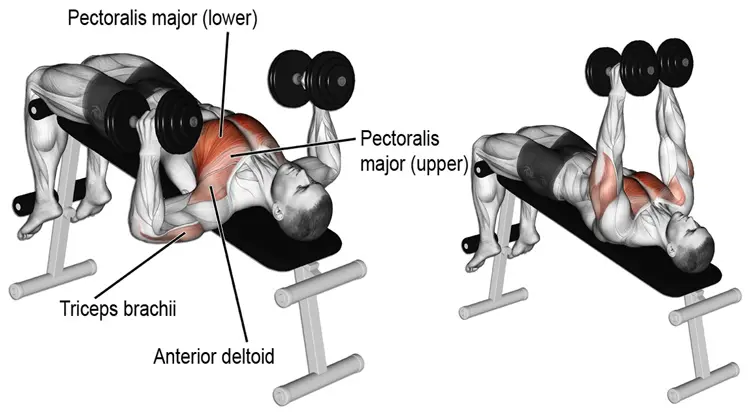
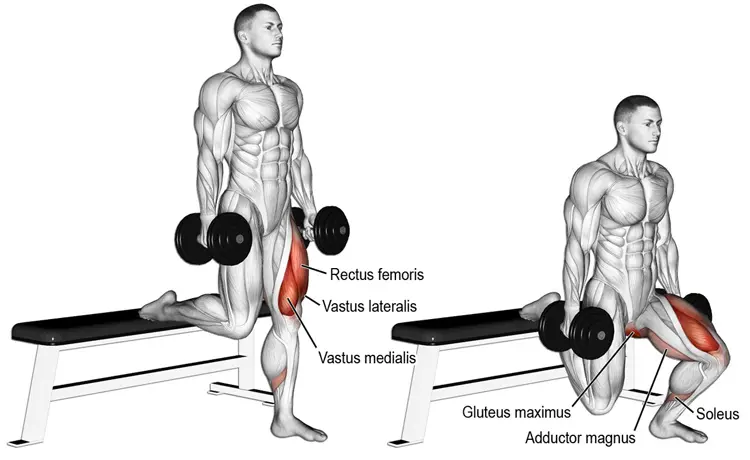
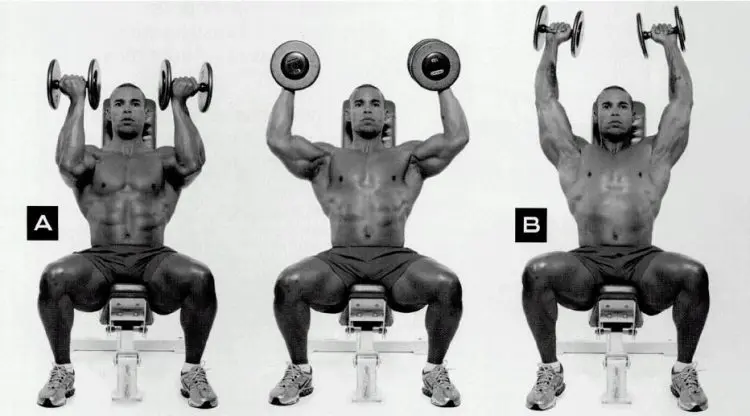
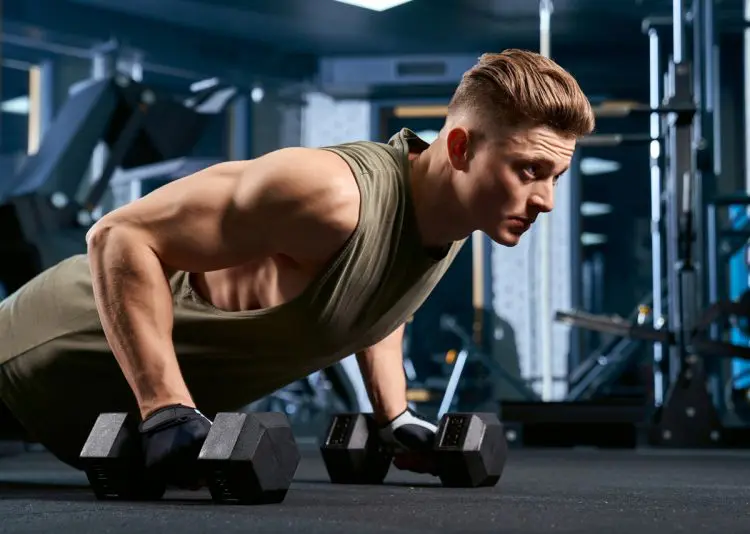
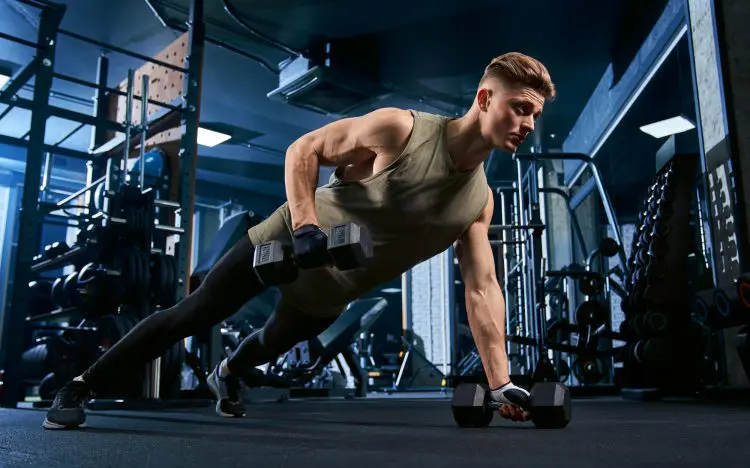

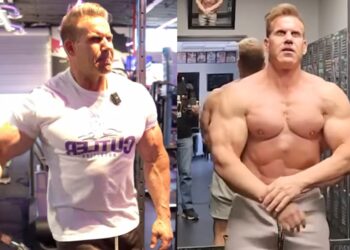
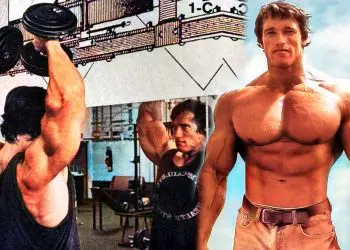
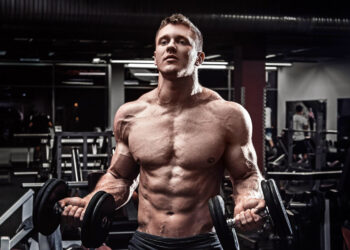
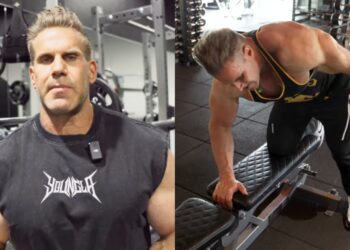



Good workout
When you say 4 sets, does this mean 4 working sets, like I should add 1-2 warmup sets? Or all is 4 sets after like a full body quick warmup?
Hi Ahmad,
Yes – four work sets, but it’s okay to do less if you feel tat’s too many. Warm up as you see fit, but you should only need 1-2 light sets of the first exercise or so before starting your work sets.
Hope that helps!
Also, am I supposed to reach failure on the last set of near failure? I’m training for hypertrophy mainly
Thanks in advance
Hi Ahmad,
Anywhere from 1-3 reps within failure will result in hypertrophy. Feel free to take the last set to complete failure if you wish, but it’s not 100% necessary. Getting close to failure is usually enough for muscle growth.
Good luck with your training!
Thanks a lot. This program is awesome. It checks all the boxes and it works in home or a gym…
You are welcome!